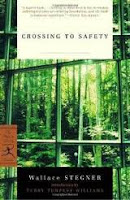 Who is Wallace Stegner? He's a twentieth century midwest American writer, who won the Pulitzer Prize in 1972. He's renowned in Utah, where he grew up, and commemorated at the west-coast university where he taught creative writing with a writing award.
Who is Wallace Stegner? He's a twentieth century midwest American writer, who won the Pulitzer Prize in 1972. He's renowned in Utah, where he grew up, and commemorated at the west-coast university where he taught creative writing with a writing award.
But he's not an author who has received much attention in Australia. Crossing to Safety was his last novel, released in 1987, a full fifty years after his first. According to the book jacket, Australia started at the end with Stegner, as this was his first title to be published here. It carries endorsement from no less than Tim Winton, who calls Crossing to Safety a 'wise and good book...I with [it] was one of mine'.
It is certainly a book of an old writer. (Stegner was almost 80 when it was published.) It's a reflective story, beginning with Larry Morgan arriving at a remote Vermont lake compound with his crippled wife, Sally, to meet their lifelong friends, Charity and Sid Lang. Charity is terminally ill, and, as befits her character, has summoned those closest to her in her final days to farewell her life as she decrees. It's obvious much time has passed since the two couples last saw each other - a gap born of argument or disagreement, or the reality of dispersed living?
Gentle tensions exist throughout the book. Stegner has a storyteller's mastery of suspense. Not edge-of-your-seat, monster-under-the-bed suspense, but rather genuine drama, a level of engagement that makes you care if characters are about to be hurt or disappointed.
What is most apparent in this novel's style is that it is a straightforward story. Yes, there are two timelines, but they rarely intersect. For the majority of the novel we are in the thirties, when pregnant women drank and a hotel cost a couple of bucks. Stegner recounts the relationship between wealthy, effervescent Sid and Charity, and poor, ambitious Larry and Sally in measured tones, taking his time over details. About two thirds of the way through he starts to drop hints of a drama to come, which is duly played out in the novel's last third.
You notice while reading it how rarely a novel these days is able to simply tell a story. Stegner allows himself one trope - Larry, the protagonist, is a writer, and he comments on the process of writing within the story, which, we assume, he is in fact penning in character as a memoriam of a lasting friendship. It's a little cliched, particularly in the beginning of the third act, when we return to modern day and Larry and Sally at the Langs' Vermont lakehouse. The Morgans breakfast with Sid and Charity's daughter, catching up on the events the reader has missed in the many years not recounted in detail. For a few pages, it's straight exposition dressed up as dialogue, and it jars a little. Mainly because up until then Stegner has relied on the poetry of his own prose to reveal intimacies, rather than characters delivering it in straight voice. But perhaps any hint of cliche only comes from so many authors repeating this style in the literature of the last thirty years.
Although the novel is adamant about its time setting - the Depression is a significant backdrop - it resonates more than once with issues that reveal themselves as timeless. Take this dinner-time discussion with 'Uncle Richard', a publisher whom Charity is hoping to woo into taking on Larry's novel:
'Uncle Richard...suggested that publishing was not a charitable enterprise. He named six titles on his fall list that he would be unable to publish if he weren't able to count on the sales of this one that Sid thought shouldn't have been published at all.e-books face a lot of competition for the role of being the end of the printed word.
Being an academic table, we began deploring the level of popular taste. Only junk seemed to sell. Wasn't there any market for good, serious, intelligent, well-written books? There must be. Couldn't you count on a good book's finding an audience - small, maybe, but enough to carry it?'






